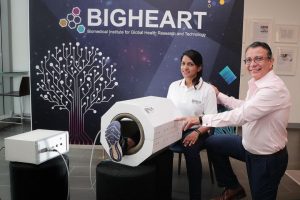Recovering from knee surgery can be slow and painful but researchers may have found a way to speed it up. Scientists in Singapore have invented a medical device to reduce recuperation time by using a magnetic field to stimulate muscle recovery.
Typically, it can take four months to heal from anterior cruciate ligament (ACL) surgery but the National University of Singapore’s (NUS) new invention can reduce that time by a month. Aptly named MRegen, it creates a magnetic field to “trick” muscle cells into thinking they are being exercised. This encourages regeneration and increases the rate of recovery.
“The device is especially useful in reducing muscle degradation in periods where physical activity is not possible,” Professor Franco-Obergón, team leader at NUS’ Biomedical Institute for Global Health Research and Technology.
The procedure is non-invasive and painless, providing a magnetic field that recreates the same regenerative, energetic and metabolic body responses as physical exercise. Two clinical trials conducted, the first in 2015 and second in 2017, yielded positive results.
The first sample consisted of ten healthy individuals that received the treatment once a week for five weeks. These patients showed an average of 30 to 40 percent improvement in muscle strength in both legs.
The second sample contained 20 individuals who had undergone ACL surgery. Half were offered a regular rehabilitation program while the remaining patients were provided with the MRegen treatment combined with the regular program. Those in the regular group recovered in 16 weeks while those in the MRegen group recovered in 12 weeks.
Additionally, MRI measurements showed that muscle metabolism improved by 50 percent. Muscle metabolism is one of the strongest signs of muscle health and restoration. These results show that MRegen offers a promising possibility for medical treatment.
Prof Franco-Obergón describes the device as nothing short of a “breakthrough” with applications that extend beyond post-op recovery. As the researcher explains, the magnetic field activates mitochondria, who work to create the energy currency of the cell called ATP. From this process, myokines are produced which are powerhouses for positive effects throughout the body.
“One of the very profound and surprising efforts, was that the myokine effect is stronger than we ever realized. Just stimulating one leg secretes myokines that get transported to the whole system,” Franco-Obergón shared in an interview. Myokine secretions are responsible for reducing blood pressure and glucose levels and even have strong anti-cancer properties.
In May 2018, the NUS research team filed a patent for the technology and has since launched a private company, QuantumTX, to market MRegen to the world. Franco-Obergón sees great potential for MRegen, including helping people with physical rehabilitation; reducing muscle loss in the elderly; and maintaining muscle mass for athletes in their off-season.























